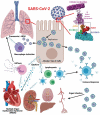SARS-CoV-2 infection: molecular mechanisms of severe outcomes to suggest therapeutics
- PMID: 33779460
- PMCID: PMC8022340
- DOI: 10.1080/14789450.2021.1908894
SARS-CoV-2 infection: molecular mechanisms of severe outcomes to suggest therapeutics
Abstract
Introduction:The year 2020 was defined by the 29,903 base pairs of RNA that codes for the SARS-CoV-2 genome. SARS-CoV-2 infects humans to cause COVID-19, spreading from patient-to-patient yet impacts patients very divergently.Areas covered: Within this review, we address the known molecular mechanisms and supporting data for COVID-19 clinical course and pathology, clinical risk factors and molecular signatures, therapeutics of severe COVID-19, and reinfection/vaccination. Literature and published datasets were reviewed using PubMed, Google Scholar, and NCBI SRA tools. The combination of exaggerated cytokine signaling, pneumonia, NETosis, pyroptosis, thrombocytopathy, endotheliopathy, multiple organ dysfunction syndrome (MODS), and acute respiratory distress syndrome (ARDS) create a positive feedback loop of severe damage in patients with COVID-19 that impacts the entire body and may persist for months following infection. Understanding the molecular pathways of severe COVID-19 opens the door for novel therapeutic design. We summarize the current insights into pathology, risk factors, secondary infections, genetics, omics, and drugs being tested to treat severe COVID-19.Expert opinion: A growing level of support suggests the need for stronger integration of biomarkers and precision medicine to guide treatment strategies of severe COVID-19, where each patient has unique outcomes and thus require guided treatment.
Keywords: COVID-19; SARS-CoV-2; acute respiratory distress syndrome.
Figures


References
Publication types
MeSH terms
Substances
LinkOut - more resources
Full Text Sources
Other Literature Sources
Medical
Miscellaneous
